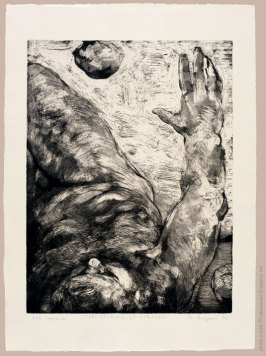A guest post by Sarah Lodwick
In my last post I raised an issue with the definition of beauty, challenging Protestants to expand the definition of beautiful art to include difficult artwork; artwork that convicts our hearts of the ways that we have failed to live the gospel as the body of Christ.
Still, there is a problem: art that points directly at social injustice in the world – that caused by our own sin – may come in the form of edgy, uncomfortable, and perhaps disgusting subject matter. Such is the nature of sin; look simply at the horrors of some traditional paintings on this theme by Michelangelo, Bosch (right), David, and Goya. While this art certainly may be convicting, before it convicts, it shocks.
Shock Art & Shocking Art
Shock art is nothing new. Marcel Duchamp is usually recognized as the first artist who pushed nineteenth century audiences to doubt their preconceived definitions of art by entering ready-made art objects in exhibitions; Fountain (below), perhaps being one of his most infamous entries.
 After Duchamp there came a deluge of artists who shocked us: the surrealists, the abstract expressionists and minimalists, the pop artists, artists who utilized kitsch in the 1980’s, and the young British artists in the 1990’s. Without describing the artwork of the last decade the point is made that the past hundred years of prominent art have developed an expectation among the public that art should shock us.
After Duchamp there came a deluge of artists who shocked us: the surrealists, the abstract expressionists and minimalists, the pop artists, artists who utilized kitsch in the 1980’s, and the young British artists in the 1990’s. Without describing the artwork of the last decade the point is made that the past hundred years of prominent art have developed an expectation among the public that art should shock us.
Shocking art has been created by artists who chose to explore a certain method or theory of art, stumbling upon something never before seen, while shock art is created precisely to shock the public for the artist’s personal gain. To a viewer who is unfamiliar with art history, there may seem to be little difference.
On the other hand, the intention of a Christian artist who desires to create moving artwork that changes peoples’ hearts for Christ’s sake is entirelly different from the intention of the artist who crafts shock art for its shock value alone. The Christian pursues a word of truth, often what is difficult to communicate to the Christian community, because of righteous concern for the people of God. For example, consider the work of Edward Knippers (left, “The Stoning of Stephen”) whose art often portrays a level of physicality and nudity that may confront but whose deeper intentions are to teach us about the importance of physicality for authentic humanity and redemption. Perhaps the Christian artist prayerfully asks God for wisdom to compose his art and when asked to defend it he prays for gracious words to explain his creation. He ultimately leaves the results of his artwork to God, understanding that God is sovereign.
hearts for Christ’s sake is entirelly different from the intention of the artist who crafts shock art for its shock value alone. The Christian pursues a word of truth, often what is difficult to communicate to the Christian community, because of righteous concern for the people of God. For example, consider the work of Edward Knippers (left, “The Stoning of Stephen”) whose art often portrays a level of physicality and nudity that may confront but whose deeper intentions are to teach us about the importance of physicality for authentic humanity and redemption. Perhaps the Christian artist prayerfully asks God for wisdom to compose his art and when asked to defend it he prays for gracious words to explain his creation. He ultimately leaves the results of his artwork to God, understanding that God is sovereign.
The shock artist, quite differently, schemes about trends in society and plots the medium and message of her artwork only after determining a weakness. She assigns a scapegoat and develops a language that will suitably impress critics while protecting her from accusations of ill motives. The two create with utterly different motives: one with concern for God’s glory, the other with selfish temporal concern. Even with these distinctions understood, questions about appropriateness, censorship, and honesty are raised when a mature Christian artist creates disturbing artwork. For this reason I continue to believe that art education is of paramount importance for the Christian.
Interpretation, Authority, & the Heart
When it comes to art, postmodernism does the most harm to Christian viewers of art not Christian artists by maintaining that the individual viewer is the ultimate authority of when it comes to interpreting artwork. Postmodernism insists that the one observing has all the interpretive power, even when the artist herself insists that one cannot understand her work apart from her artist statements. Education of the observer is irrelavant, even if a viewer has the kind of education that would clarify a pastiche of symbolism that is so often used in postmodern art.
Many Christians do not regard artistic intentions even though scripture teaches us that God searches our hearts; this is the ultimate affirmation of the importance of intention. As Christians we believe that humans are moral agents, and we will all be accountable to God for our actions and motives. For this reason, art education becomes more important for Christians so that we can truly understand art. Like any academic study or recreational pastime, increased knowledge of a subject usually increases appreciation of it, and understanding eventually increases our enjoyment of it.
Art is no different. The more we know about art history, art theory, art appreciation, the creative process, and the intention of artists-processing it all theologically-the more we will be able to discern between shock art and art that convicts us.
